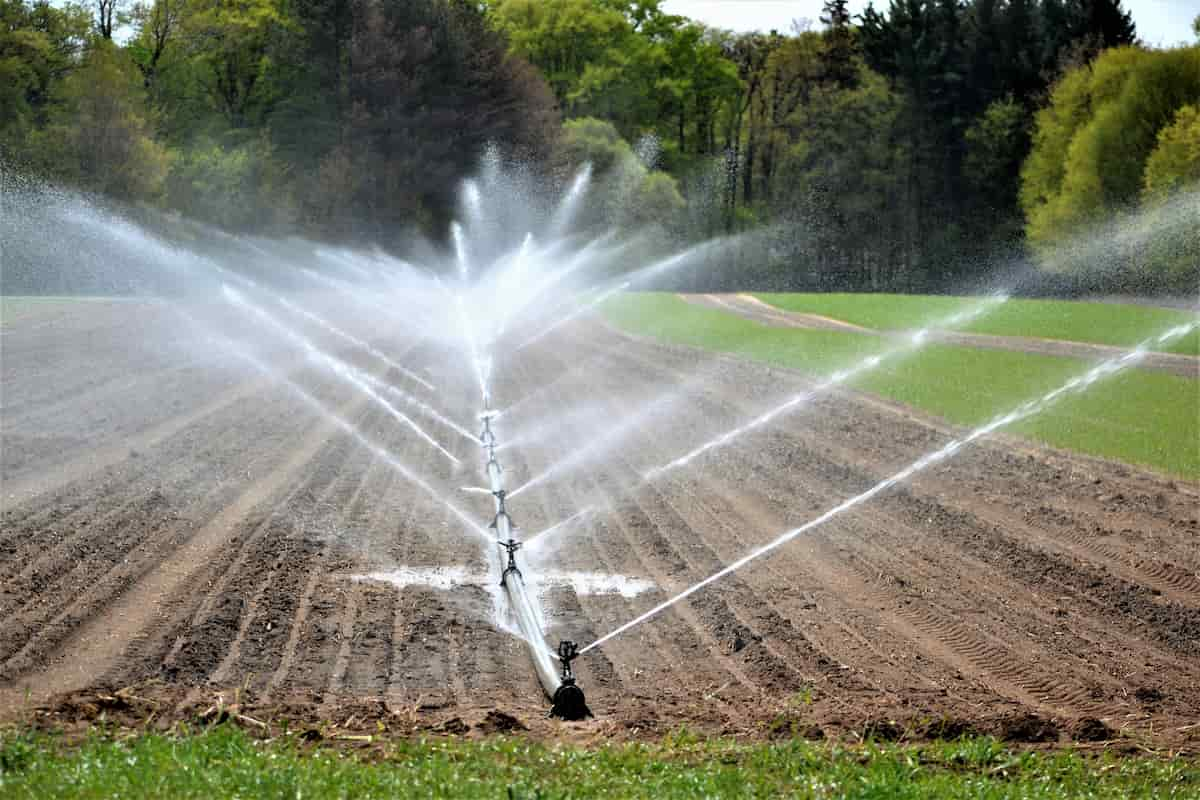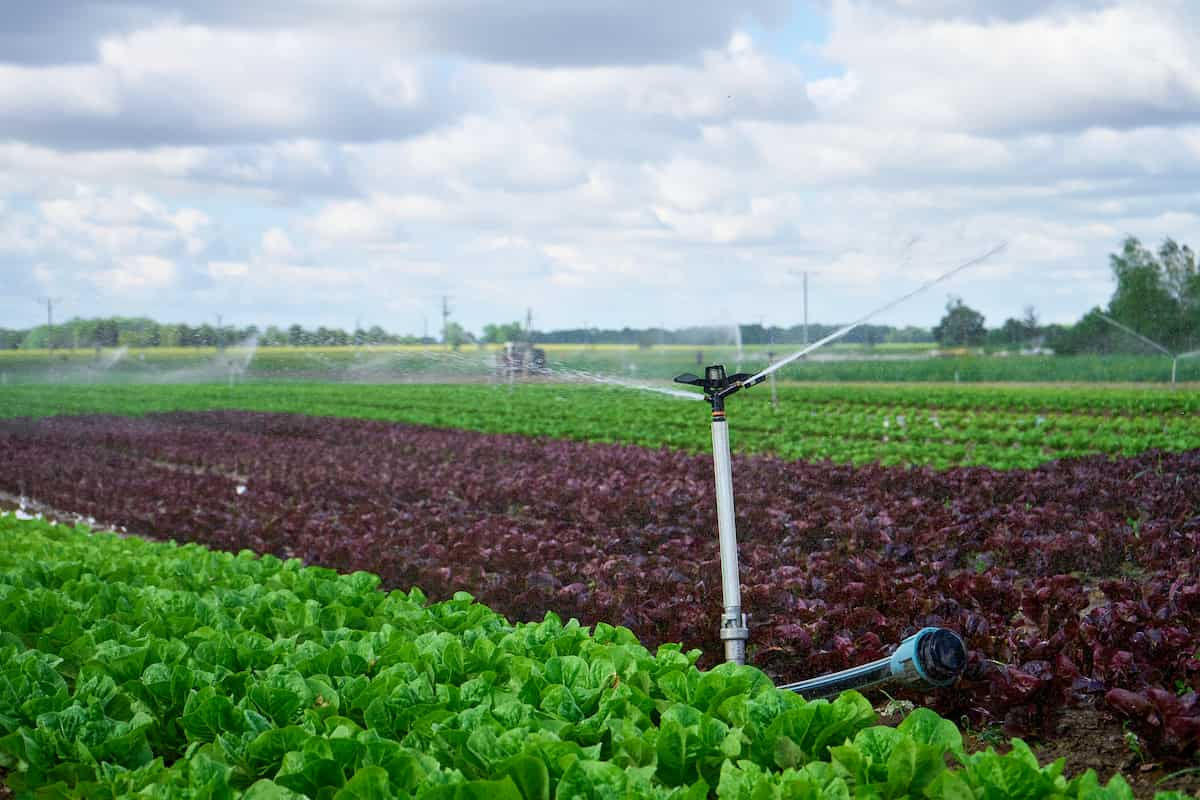A sprinkler irrigation system uses high-pressure pumps to distribute water through a network of pipes and nozzles, providing uniform irrigation to various soil types. The system can be customized by adjusting nozzle size and spacing, pipe spacing, and operating pressure to match the soil infiltration rate. Sprinkler irrigation is used on only 2.5% of India’s irrigated land, with Rajasthan and Haryana having the largest areas under irrigation.

The sprinkler irrigation system was introduced in the 1950s in India by innovative farmers in regions facing water scarcity, such as Madhya Pradesh, Haryana, Rajasthan, and parts of Punjab. Its adoption later spread to other areas in these states, as well as to Maharashtra and Karnataka.
Components Used in Sprinkler Irrigation
Sprinkler irrigation systems use a range of components to distribute water over fields. A pumping unit, consisting of a centrifugal or turbine pump, pumps water under pressure to the fields. Tubings, including mains, sub mains, and laterals, distribute water from the source to the sprinklers. Couplers connect pipes, and sprinkler heads distribute water uniformly over the field. Fittings and accessories, such as water meters, flanges, pressure gauges, and fertilizer applicators, are also important for the system’s operation.
Rotating and fixed sprinkler heads are available, with rotating types adaptable for various application rates and spacing. In contrast, fixed types suit smaller areas and soils with high intake rates. Pressure ranging from 16 to 40 meters is most practical for most farmers. Fertilizer applicators are simple and inexpensive and can be injected into the sprinkler system through a sealed fertilizer tank and venturi injector in the main water line. Using these components can lead to efficient water distribution and increased crop yields.
Horticulture Crops Grown Under Sprinkler Irrigation
Sprinkler irrigation is a popular method of watering horticulture crops, including a variety of fruits and vegetables. Some of the crops that can be grown under sprinkler irrigation include tomatoes, potatoes, onions, garlic, cabbage, cauliflower, broccoli, carrots, lettuce, spinach, peas, beans, squash, cucumber, watermelon, cantaloupe, strawberries, blueberries, grapes, and apples.
Top 10 Benefits of Sprinkler Irrigation in Horticulture
Suitability in Every Crop Production
Sprinkler irrigation is suitable for oil seeds, cereal, and vegetable crops, providing a uniform distribution of water and nutrients. This method helps improve crop yield and quality, reduce labor and water costs, and increase profitability for farmers.
In case you missed it: Top 10 Benefits of Gibberellic Acid in Agriculture

Conservation of Water by Adopting the Sprinkler Irrigation System
Sprinkler irrigation is suitable for all types of soils except for very heavy clay, as it does not cause overland water flow on the surface. This method is particularly beneficial for close-growing crops and can save up to 30% water compared to surface irrigation. Overall, sprinkler irrigation has a distinct advantage in water conservation over surface irrigation methods. Proper planning and design of a sprinkler irrigation system can achieve high water use efficiency.
No Need for Manual Labour operations
Sprinkler irrigation eliminates the need for constructing bunds, ridges, and field channels to guide or hold water. This saves land that would have been used for construction and enables it to be used for crop cultivation.
Easy Fertilizer Application and Avoid Leaching
One of the advantages of sprinkler irrigation is the ability to apply chemicals and fertilizers along with water. This method helps save fertilizers and other nutrients as there is no deep percolation and leaching, allowing crops to receive an even distribution of water and nutrients.
Easy Mobility of Sprinkler Irrigation System
Sprinkler irrigation systems offer easy mobility as they can easily move from one area to another. Portable systems can be installed temporarily, easily dismantled, and relocated to another area. Sprinkler irrigation is an ideal option for farmers who plan to rotate their crops or use their land for other purposes in the future.
Acceptable in All Soil Types
Sprinkler irrigation is a versatile method suitable for irrigating all types of soils except for heavy clay. This method is particularly useful for soils with a low intake rate, as it can deliver water evenly and gradually to prevent runoff and soil erosion. Sprinkler irrigation is adaptable to uneven terrain and can be tailored to meet specific field needs. It minimizes soil compaction, improves crop growth, and is an excellent option for maximizing yield potential.
No Clogging of Nozzles
Advantage of sprinkler irrigation: less clogging of sprinkler nozzles due to water being pumped under pressure and sprayed through nozzles, reducing sediment build-up in the irrigation system.
Protection of the Crops
Sprinkler irrigation can help protect crops during cold winter nights by creating a layer of ice on the plant surface, insulating the crop from freezing temperatures. On the other hand, during hot summer days, sprinklers can cool crops by spraying water droplets on the plant surface, reducing the temperature and relieving heat stress. This method is particularly useful in areas where extreme temperatures can damage crops.
Less Infestation of Pests
Sprinkler irrigation can help reduce the infestation of pests and diseases in crops as it does not excessively wet the foliage of plants. Wet foliage promotes the growth of fungal and bacterial diseases in plants. Moreover, sprinkler irrigation can be used for applying pesticides and fungicides to crops, which can effectively control pests and diseases.
Increase in Yield
Sprinkler irrigation can significantly increase crop yield by providing clean water and nutrient application, leading to healthy plant growth and higher productivity. The water and nutrient supply can be accurately regulated, preventing both under- and over-irrigation, which can result in yield loss. Additionally, the system’s ability to apply chemicals and fertilizers with water can promote plant growth, further enhancing crop yield.
In case you missed it: 10 Benefits of Groundnut Cake Powder Manure in Your Terrace Garden: Uses, When and How to Apply

Conclusion
Sprinkler irrigation offers numerous benefits for horticulture. It is suitable for many crops and soil types, saves water, allows for easy application of chemicals and fertilizers, and improves crop yield while reducing pest infestations. It also offers flexibility and mobility, making it an ideal choice for protecting crops from frost and heat. Overall, sprinkler irrigation is an efficient and effective method for horticulture.
- Feed Your Flock for Less: Top 10 Tips to Save on Chicken Feed
- Ultimate Guide to Ossabaw Island Hog: Breeding, Raising, Diet, and Care
- Hatching Answers: The Top 10 Reasons Your Chickens Aren’t Laying Eggs
- Eggs and Economics: Breaking Down the Cost of Raising Backyard Chickens
- Defend Your Greens: Proven Methods to Keep Iguanas Out of Your Garden
- Ultimate Guide to Cinnamon Queen Chicken: A Comprehensive Guide for Beginners
- Ultimate Guide to California Tan Chicken: Breeding, Raising, Diet, Egg-Production and Care
- Ultimate Guide to Marsh Daisy Chicken: Breeding, Raising, Diet, and Care
- 10 Types of Chicken Farming Businesses You Can Start for Profits